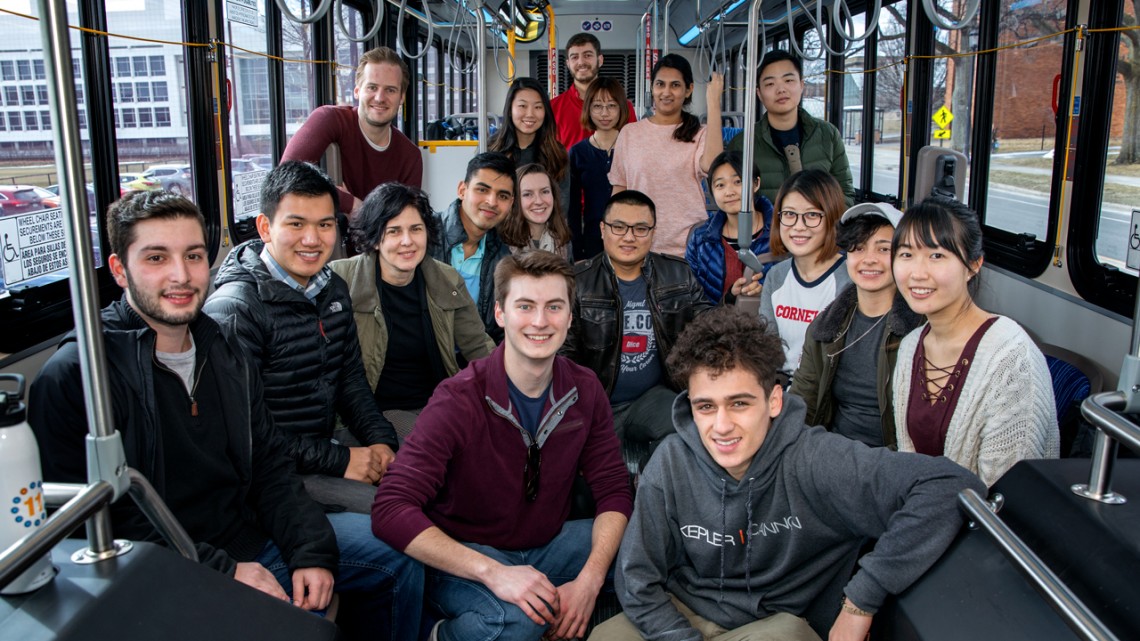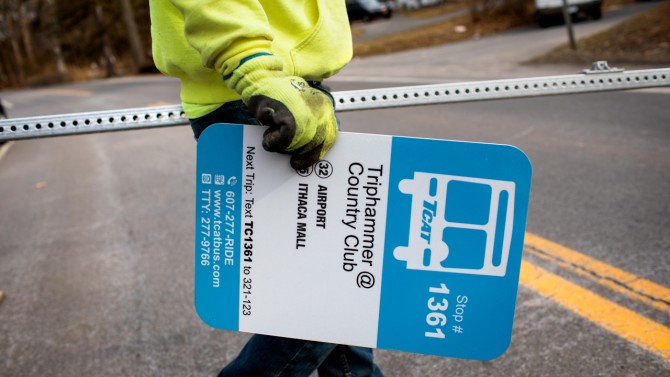
Current students from the College of Engineering's "Design Thinking for Complex Systems" course and from CUSD's Sustainable Mobility team board a new TCAT bus. The class and the team helped to design new signs for the bus system.
Students’ bus stop sign design becomes roadside reality
By Blaine Friedlander
Tompkins Consolidated Area Transit – or TCAT – is installing nearly 560 bus stop signs, redesigned in partnership with Cornell systems engineering students and the Cornell University Sustainability Design (CUSD) group.
With the new, bright blue-and-white signs, riders will get consistency, clarity, route detail and location, and – through text messages – learn when the next bus arrives. TCAT will be replacing the signs throughout this spring.
The bus system has 33 routes throughout Tompkins County, providing 4 million individual rider trips per year and logging 1.6 million revenue miles. The older TCAT bus stop signs reflected a mélange of styles, sometimes had out-of-date information and touted bus routes long gone. The new signs will help riders better navigate the routes, said Scot Vanderpool, TCAT’s general manager. “These signs will help take the mystery out of riding the bus.”
Matt Yarrow, service development manager for TCAT, praised the design work, which began with a collaboration between a systems engineering class in spring semester 2017 and finished with the CUSD’s Sustainable Mobility team last fall.
“We really liked the ideas the students came up with,” Yarrow said. “They conducted interviews and studies with riders, and proposed several ideas based on the concept where new elements and information could be added at high-ridership stops.”
Originally, TCAT and a diverse team of students based in Cornell Systems Engineering had begun creating new designs for bus stop shelters. Redesigning signs was a spin-off project.
In the first phase of redesigning signs during the 2017 spring semester, students from the course Design Thinking for Complex Systems engaged in empathy fieldwork, where riders explained their preferences. Their research found that riders desire minimal interaction to obtain information, which is why the students’ suggestions became grounded in simplicity, according to engineering lecturer Sirietta Simoncini, who teaches the course. At the end of semester, the students presented their first ideas to TCAT.
For last fall semester, the CUSD’s Sustainable Mobility team – led by Kristen Vilcans, M.Eng. ’17 – continued with the project and helped shape ideas. For example, there will be longer, detailed signs at the highly trafficked Ithaca Commons stops and shorter, more succinct signs along routes into Lansing and Newfield. This semester, the CUSD’s Sustainable Mobility group is being led by Byung Hee Chun ’18.
After the sign ideas were submitted, TCAT service analyst Tom Clavel created a new system to number each bus stop so that riders could use mobile phone text messaging – without the need for a smartphone.
For example, the bus stop at State Street/Martin Luther King Street and Quarry Street is No. 1703. A rider with a simple mobile phone or smartphone can text TC1703 to 321-123. Almost instantly, the rider will receive an automatic message with information about which times buses will arrive at that stop.
TCAT graphic artist Jenn Jennings polished the students’ design details and made the signs compliant with the Americans with Disabilities Act.
Simoncini explained that the Sustainable Mobility team project, which also encompasses redesigning bus shelters and making routes more efficient, is close to student hearts.
“The students use the bus system. They are part of this community,” she said. “The best part is that students are able to see their ideas implemented.”
Media Contact
Get Cornell news delivered right to your inbox.
Subscribe

